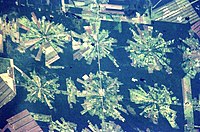
Photo from wikipedia
ABSTRACT Successful plant recruitment is crucial for maintaining forest ecosystems, but knowledge of the responses of early life stages of tropical montane tree species to complex environmental factors is still… Click to show full abstract
ABSTRACT Successful plant recruitment is crucial for maintaining forest ecosystems, but knowledge of the responses of early life stages of tropical montane tree species to complex environmental factors is still limited across the Himalayas. Vegetation was surveyed along an altitudinal gradient (2450–3070 m) in six altitudinal bands in a tropical montane forest of Myanmar. We examined the effects of microclimate, soil, and microsite conditions on seedling and sapling recruitment in three dominant tree species (Quercus semecarpifolia, Rhododendron arboreum, and Symplocos lucida). We found that densities of R. arboreum and Q. semecarpifolia were higher in high and mid-altitudinal bands (2800–3000 m), whereas density of S. lucida was higher in lower altitudinal bands (2600–2700 m). Seedlings showed better recruitment in humid conditions and more sensitive to soil properties than saplings. R. arboreum and S. lucida preferred debris microsites, followed by shrub and grass microsites, whereas Q. semecarpifolia showed no significant microsite preference. Seedling recruitment mainly depended on soils and microsites, whereas sapling recruitment depended on microclimate and altitude. The study provides information on species-specific preferences and responses of montane tree species to complex environmental factors, which may contribute to restoration and sustainable forest conservation.
Journal Title: Journal of Sustainable Forestry
Year Published: 2020
Link to full text (if available)
Share on Social Media: Sign Up to like & get
recommendations!